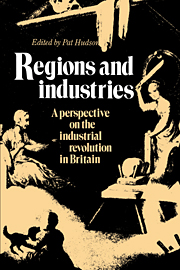Book contents
- Frontmatter
- Contents
- List of figures
- List of maps
- List of tables
- List of contributors
- Acknowledgements
- Introduction
- 1 The regional perspective
- PART ONE THE TEXTILE HEARTLANDS OF THE INDUSTRIAL REVOLUTION
- PART TWO OTHER PATHS, OTHER PATTERNS
- PART THREE THE DIVERSE NATURE OF THE OUTER REGIONS
- 8 Two paths to economic development: Wales and the northeast of England
- 9 Proto-industrialisation in Scotland
- 10 The environment and dynamic of pre-factory industry in Northern Ireland
- Index
10 - The environment and dynamic of pre-factory industry in Northern Ireland
from PART THREE - THE DIVERSE NATURE OF THE OUTER REGIONS
Published online by Cambridge University Press: 05 May 2010
- Frontmatter
- Contents
- List of figures
- List of maps
- List of tables
- List of contributors
- Acknowledgements
- Introduction
- 1 The regional perspective
- PART ONE THE TEXTILE HEARTLANDS OF THE INDUSTRIAL REVOLUTION
- PART TWO OTHER PATHS, OTHER PATTERNS
- PART THREE THE DIVERSE NATURE OF THE OUTER REGIONS
- 8 Two paths to economic development: Wales and the northeast of England
- 9 Proto-industrialisation in Scotland
- 10 The environment and dynamic of pre-factory industry in Northern Ireland
- Index
Summary
Irish history is apt to be obscured by a cloud of semantics so, at the outset, Northern Ireland is defined as the historic nine-county province of Ulster: Antrim, Armagh, Cavan, Donegal, Down, Fermanagh, Londonderry, Monaghan and Tyrone. This is neither geographically nor economically a homogeneous region but the outcome of an amalgam of Gaelic-Irish and Anglo-Irish lordships and subjected to substantial English and Scottish settlement from the late sixteenth century. Since 1922 six of the nine counties have formed a smaller political unit – also called, confusingly, Ulster or Northern Ireland – and as with the larger area this too lacks an economic unity.
By virtue of physical geography and climate there exist many variations in landscape and settlement patterns in Ulster. These range from extensive areas of lowland in the valleys of the Lagan, Bann and Foyle, the Lough Neagh basin, Counties Fermanagh and Cavan, and the eastern lowlands of Antrim and north Down to the mountain masses of the Sperrins and Mournes, the rocky uplands of north-west Donegal and north Antrim and the chain of drumlins stretching from south Donegal to the Ards peninsula. Rainfall and temperature made Ulster natural pasture country but local needs and, in the later eighteenth and early nineteenth centuries, the demands of distant markets, created an extensive mosaic of small tillage farms producing mainly potatoes and oats, the former for subsistence and the latter for sale.
Is there then any sort of unity that justifies treating the nine-county Ulster as a single region in the pre-factory age, a period defined for present purposes as roughly 1700–1850! Three unifying themes can be identified.
- Type
- Chapter
- Information
- Regions and IndustriesA Perspective on the Industrial Revolution in Britain, pp. 252 - 270Publisher: Cambridge University PressPrint publication year: 1989
- 4
- Cited by



